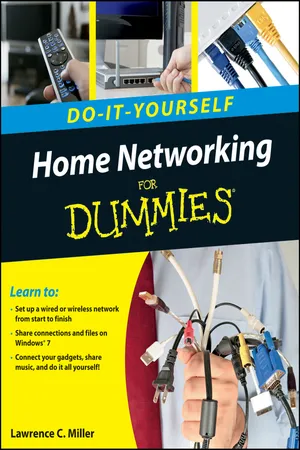
This is a test
- English
- ePUB (mobile friendly)
- Available on iOS & Android
eBook - ePub
Home Networking Do-It-Yourself For Dummies
Book details
Book preview
Table of contents
Citations
About This Book
Step by step guide to connecting all your electronic devices into one network
A home network allows you to share Internet connections, photos, video, music, game consoles, printers, and other electronic gadgets. This do-it-yourself guide shows you step by step how to create a wired or wireless network in your home.
In the For Dummies tradition of making technology less intimidating, Home Networking Do-It-Yourself For Dummies breaks down the process into easy steps with clear instructions.
- Increasing broadband speeds, cellular technology, the explosive growth of iPhone sales, and the new Home Group feature in Windows 7 all contribute to a booming interest in home networking
- This step-by-step guide walks do-it-yourselfers through the process of setting up a wired or wireless network with Windows 7 and Windows Vista
- Demonstrates how to connect desktops or laptops, printers, a home server, a router, high-speed Internet access, a video game system, a telephone line, and entertainment peripherals
- Shows how to share files, music, and video, and connect to an iPhone
- Provides maintenance and troubleshooting tips
Home Networking Do-It-Yourself For Dummies enables you to take advantage of everything a home network can offer without hiring a technology wizard.
Frequently asked questions
At the moment all of our mobile-responsive ePub books are available to download via the app. Most of our PDFs are also available to download and we're working on making the final remaining ones downloadable now. Learn more here.
Both plans give you full access to the library and all of Perlego’s features. The only differences are the price and subscription period: With the annual plan you’ll save around 30% compared to 12 months on the monthly plan.
We are an online textbook subscription service, where you can get access to an entire online library for less than the price of a single book per month. With over 1 million books across 1000+ topics, we’ve got you covered! Learn more here.
Look out for the read-aloud symbol on your next book to see if you can listen to it. The read-aloud tool reads text aloud for you, highlighting the text as it is being read. You can pause it, speed it up and slow it down. Learn more here.
Yes, you can access Home Networking Do-It-Yourself For Dummies by Lawrence C. Miller in PDF and/or ePUB format, as well as other popular books in Computer Science & Computer Networking. We have over one million books available in our catalogue for you to explore.
Information
Part I
Doing Your Homework

In this part . . .
Don’t worry — it isn’t a graded assignment! But you do need to know why you’re building a home network and understand some basics about networking before you get started. So in this part, I help you explore the possibilities for your home network, explain some networking terms and concepts, and describe some basic networking equipment.
Chapter 1
Why Do You Need A Home Network?
In This Chapter



Computer networks allow you to easily share resources with others. These resources may include Internet access, shared files and folders, printers, and much more. In this chapter, you explore the benefits of creating your own home network.
A Network by Any Other Name
A network is a group of computers that communicate with each other in order to share resources, such as Internet access, computing power, files and folders, printers, and even the computers themselves.
If you’ve worked on a corporate or office network, you may have heard the network referred to as the LAN, which is simply a local area network. Your home network can also be correctly described as a LAN. There is no hard and fast rule for how small or large a network must be in order to be considered a LAN. It may consist of as few as two computers or as many as several hundred computers.
Another acronym you may hear when referring to a network is WAN, or wide area network, which connects multiple networks together. For example, a corporation may connect several of its locations together on a private WAN. The biggest example of a WAN is the Internet, which connects networks as small as one computer to as large as thousands of computers together over the Internet.
Table of contents
- Cover
- Table of Contents
- Title Page
- Introduction
- Part I: Doing Your Homework
- Part II: Installing Your Home Network
- Part III: Setting Up Your Windows 7 Network
- Part IV: Keeping Your Network Safe and Healthy
- Part V: The Part of Tens
- Cheat Sheet
